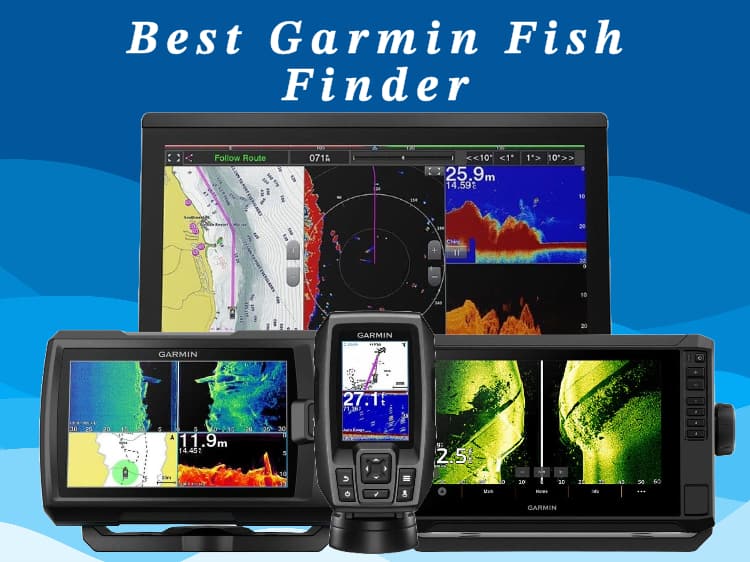Hey buddy! So, you’re interested in a Garmin fish finder? They’re a solid choice. Garmin is known for making some of the best fish finders with great features. When choosing one, it’ll boil down to what kind of fishing you do, where you fish, your boat type, and of course, your budget.
I’ll break down the best models and help you pick the best option for your needs. Keep on reading!
Best Large Screen: Garmin GPSMAP 8600XSV Chartplotter Sonar Combo

The Garmin’s GPSMAP 8600XSV Chartplotter series boasts full HD in-plane switching (IPS) touchscreen displays, ensuring wide viewing angles, superior clarity, and readability in sunlight. They are offered in the 10, 12, and 16-inch screen sizes. The 16-inch is the largest screen offered by Garmin in its fish finder with built-in sonar capabilities.
GPSMAP 8600XSV units come preloaded with Garmin Navionics+ charts and support advanced GPS with Auto Guidance+ technology. They also offer Ultra High-Definition SideVü and ClearVü scanning sonars, ensuring clear and detailed views of underwater structures and fish schools. The 1 kW CHIRP traditional sonar further adds to its depth capability, making it suitable for shallow and deep saltwater environments.
Here is the comparison of Garmin’s GPMAP 8600XSV series models:
| Model | Screen Size | Display | Price |
|---|---|---|---|
| GPSMAP 8610XSV | 10 inch | WUXGA, IPS | Check Price |
| GPSMAP 8612XSV | 12 inch | FHD, IPS | Check Price |
| GPSMAP 8616XSV | 16 inch | FHD, IPS | Check Price |
Best for LiveScope: Garmin Echomap UHD2 Chartplotter

The Garmin’s Echomap UHD2 chartplotters come in 5″, 6″, 7″, and 9″ screen sizes. The UHD2 SV (SideVu) models support a touchscreen whereas the UHD2 CV (ClearVu) models have a keyed interface.
Echomap UHD2 models are compatible with Garmin transducers that support Ultra High Definition ClearVü and SideVü scanning sonars for a detailed view beneath your vessel. The sonar capabilities are further enhanced with compatibility for LiveScope live scanning sonar, providing real-time images of fish movements and underwater structures.
The Echomap UHD2 comes preloaded with Garmin Navionics+ cartography, offering detailed maps and helpful navigational aids for a wide range of water bodies. This GPS integration helps mariners understand the waters they’re navigating with more confidence and precision.
Below is a comparison of Garmin’s Echomap UHD models.
| Model | Screen Size | Sonar Capabilities | Maps | Price | Review |
|---|---|---|---|---|---|
| ECHOMAP UHD2 93SV | 9-inch | SideVü, ClearVü, Traditional CHIRP | Navionics+ Inland | Check Price | Read Review |
| ECHOMAP UHD2 94SV | 9-inch | SideVü, ClearVü, Traditional CHIRP | Navionics+ Coastal | Check Price | |
| ECHOMAP UHD2 73SV | 7-inch | SideVü, ClearVü, Traditional CHIRP | Navionics+ Inland | Check Price | Read Review |
| ECHOMAP UHD2 74SV | 7-inch | SideVü, ClearVü, Traditional CHIRP | Navionics+ Coastal | Check Price | |
| ECHOMAP UHD2 73CV | 7-inch | ClearVü, Traditional CHIRP | Navionics+ Inland | Check Price | |
| ECHOMAP UHD2 74CV | 7-inch | ClearVü, Traditional CHIRP | Navionics+ Coastal | Check Price | |
| ECHOMAP UHD2 63SV | 6-inch | SideVü, ClearVü, Traditional CHIRP | Navionics+ Inland | Check Price | |
| ECHOMAP UHD2 64SV | 6-inch | SideVü, ClearVü, Traditional CHIRP | Navionics+ Coastal | Check Price | |
| ECHOMAP UHD2 53CV | 5-inch | ClearVü, Traditional CHIRP | Navionics+ Inland | Check Price | |
| ECHOMAP UHD2 54CV | 5-inch | ClearVü, Traditional CHIRP | Navionics+ Coastal | Check Price |
Best for Tournament Anglers: Garmin Echomap Ultra
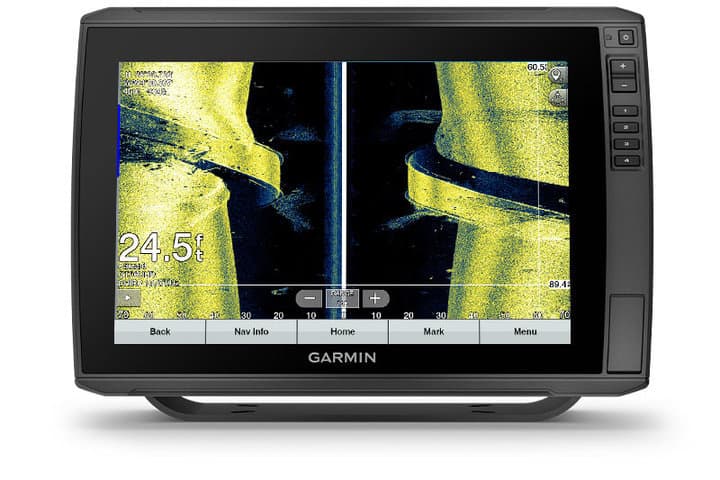
Key Features of Echomap Ultra:
- Available in 10-inch and 12-inch touchscreen displays
- Compatible with both Garmin’s GT56UHD and GT54UHD transducers.
- Offers Ultra high-definition traditional CHIRP sonar, ClearVü, and SideVü scanning sonars.
- Preloaded Garmin’s Navionics+ charts for a detailed view of both coastal and inland waters.
- LiveScope Compatible
- Advanced networking capabilities
Garmin’s Echompa Ultra 126sv or Ultra 106sv is tailored for professional anglers or those who participate in professional tournaments. The high-definition sonar, GPS, and support for Panoptix LiveScope can be critical for those seeking competitive advantages.
Given the larger screen sizes and networking capabilities, the Ultra series is ideal for larger boats where multiple screens or devices might be used simultaneously, and data sharing across devices is beneficial.
Read the detailed review of Ultra 126sv and also the Ultra 106sv review for an in-depth analysis of their features.
Best for Kayak: Garmin Striker Vivid GPS Fish Finder
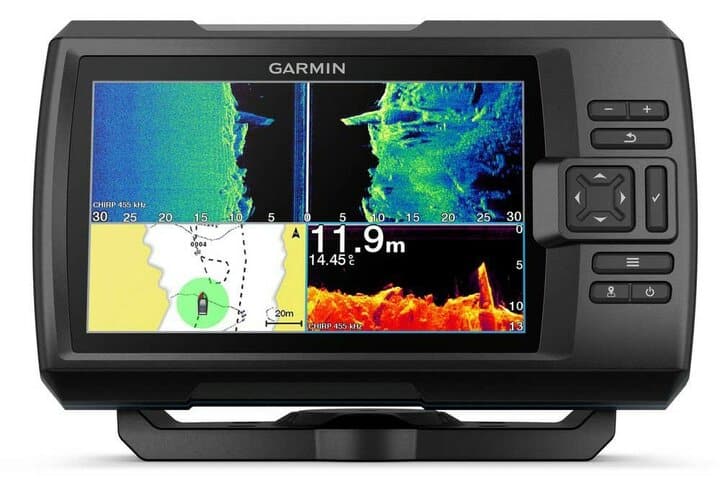
The Garmin’s Striker Vivid GPS Fish Finders cater to various angling scenarios and boat types. For those with small boats, such as kayaks or Jon boats, the Striker Vivid 4cv would be a fitting choice. It’s compact, budget-friendly, and offers the essential sonar features for beginner anglers.
The Striker Vivid 7sv or 9sv are the best options for shallow water anglers with medium sized boats. These offer larger screen sizes, and the ‘sv’ models have SideVü capabilities, providing a more comprehensive view of the underwater environment.
Below is a comparison of Garmin’s Striker Vivid models:
| Model | Screen Size | Sonar Capabilities | GPS | Price | Review |
|---|---|---|---|---|---|
| Striker Vivid 9sv | 9-inch | SideVü, ClearVü, Traditional CHIRP | Built-in | Check Price | Read Review |
| Striker Vivid 7sv | 7-inch | SideVü, ClearVü, Traditional CHIRP | Built-in | Check Price | Read Review |
| Striker Vivid 7cv | 7-inch | ClearVü, Traditional CHIRP | Built-in | Check Price | |
| Striker Vivid 5cv | 5-inch | ClearVü, Traditional CHIRP | Built-in | Check Price | Read Review |
| Striker Vivid 4cv | 4-inch | ClearVü, Traditional CHIRP | Built-in | Check Price | Read Review |
Best Cheap: Garmin Striker 4 GPS Fish Finder
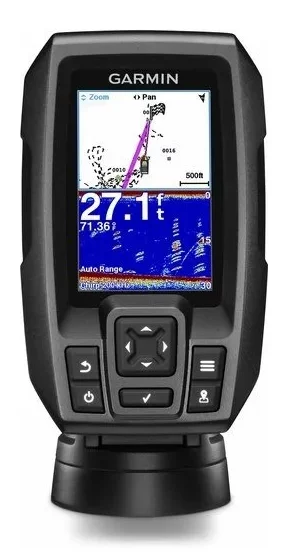
Striker 4 is one of the cheapest fish finder and depth finder by Garmin. It’s an excellent choice for beginners looking for a depth finder with basic sonar. Here are its key features:
- Display: Comes with a 3.5-inch color screen that, while basic, provides clear sonar readings and is easy to navigate.
- Sonar Capabilities: Employs traditional CHIRP sonar, which enhances clarity and target separation compared to non-CHIRP models. This makes spotting individual fish and identifying bait schools more straightforward.
- Waypoint Map: While it lacks advanced mapping features, the Striker 4 allows users to view, mark, and navigate to locations, such as brush piles, stumps, and docks.
- Built-in GPS: Useful for marking favorite fishing spots and navigating back to them. It also provides speed data, helping anglers to ensure they’re trolling at optimal speeds.
The Striker 4 is budget-friendly and offers the basic functionalities one needs for successful outings. You can read our detailed Garmin Striker 4 Review to find out its features in more detail.
Best for Ice Fishing: Garmin STRIKER Plus 4 Ice Fishing Bundle
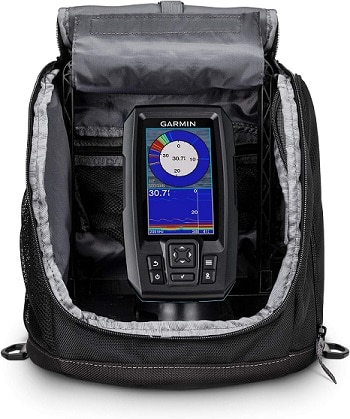
The Garmin’s STRIKER Plus 4 Ice Fishing Bundle is a compact and user-friendly 4” color fishfinder designed specifically for ice fishing enthusiasts. It comes with a built-in, high-sensitivity GPS that allows anglers to not only locate fish beneath the ice but also mark and navigate back to their favorite hot spots, docks, and ramps with ease.
This bundle includes a dual-beam ice fishing transducer which utilizes Garmin CHIRP traditional sonar to deliver crystal-clear images and exceptional target separation, enabling fishers to see exactly what is beneath the ice. The device also features built-in Quickdraw Contours mapping, which lets users create and store maps with 1-foot contours for up to 2 million acres.
To complement the rugged outdoor ice fishing environment, the STRIKER Plus 4 comes with a durable carrying case that neatly fits the device and accessories, making it easy to transport and protect against the harsh winter elements.
Best Portable: Garmin Striker Cast GPS
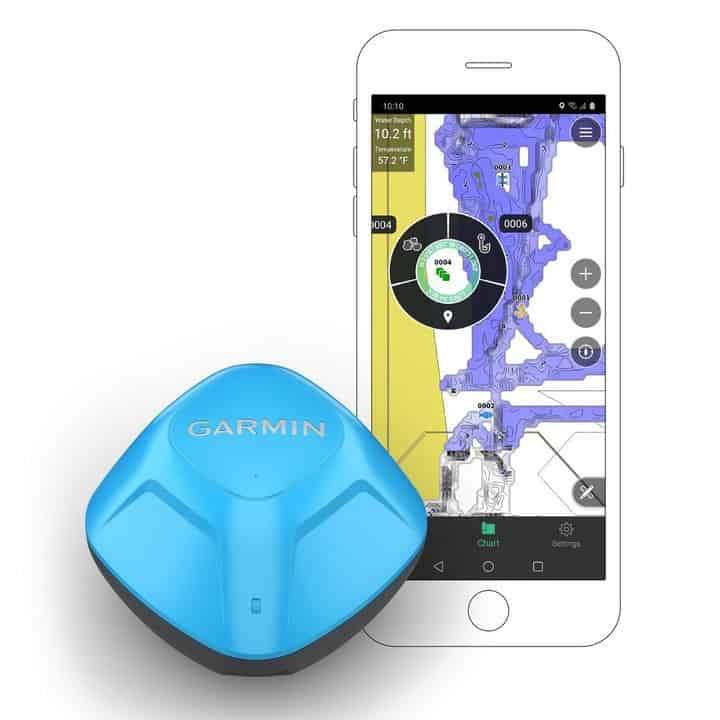
Striker Cast GPS is the best Garmin portable fish finder with its own unique attributes:
- Castable Design: As the name suggests, the Striker Cast is a sonar device that can cast out into the water, allowing anglers to scan areas that boat-mounted fish finders might not easily access. It’s especially useful for shore-based anglers or those fishing from non-motorized vessels like kayaks or canoes.
- Sonar Capabilities: The device provides clear, crisp fish arches and detailed contour images of the underwater environment. It works in both freshwater and saltwater and can scan depths up to 150 feet.
- GPS Integration: One of the standout features of the Striker Cast is its built-in GPS. This enables anglers to create custom fishing maps with 1’ contours, which can be a game-changer for understanding local fishing spots. The GPS also allows users to mark fishing hotspots, so they can return to productive areas in the future.
- Mobile App Compatibility: The Striker Cast pairs with a mobile app on the smartphone or tablet turning the smartphone into a fully functional fish finder. Anglers can view sonar data, customize settings, and even save fishing spots through the app.
Garmin Fish Finder Screen Sizes
Garmin offers a wide range of fish finders with various screen sizes to suit different needs and preferences, ranging from compact and portable units to larger, more advanced displays. Here’s an overview of the typical screen sizes you might find in Garmin’s fish finder and chartplotter lines:
- Compact/Portable: 3.5 to 4 inches
- Models like the STRIKER 4 or STRIKER Vivid 4cv fall into this category.
- Ideal for kayaks, small boats, or as a secondary unit.
- Small to Medium: 5 to 7 inches
- Examples include the STRIKER Plus 5cv and the Echomap UHD 73sv.
- Balance between portability and readability, popular for a wide range of vessels.
- Medium: 7 to 9 inches
- Models like the Echomap UHD 73sv or STRIKER Vivid 9sv.
- Offer more detailed views and compatible with more advanced features.
- Large: 9 to 12 inches
- Such as the Echomap UHD 93sv or the Echomap Ultra 126sv.
- Provide extensive detail and are suitable for mid-sized to larger boats where screen readability at a distance is important.
- Extra-Large: 12 inches and above
- Models like the GPSMAP 8612xsv Touch or larger options in the 8600 series with screen sizes up to 24 inches.
- Offer expansive views, high-resolution displays, and a wide range of advanced features. Ideal for professional use or serious enthusiasts.
Garmin Fish Finder Maps and GPS
Garmin fish finders are renowned for their integration of advanced mapping and GPS features, enhancing the fishing and navigational experience for users. Here’s a brief overview of the key mapping and GPS features typically found in Garmin fish finders:
- High-Sensitivity GPS: Garmin fish finders include high-sensitivity GPS that quickly and accurately locates your position and maintains it even in heavy cover and deep canyons. This feature is crucial for marking waypoints, navigating to specific locations, and tracking your movement on the water.
- Quickdraw Contours: Many models come with Garmin Quickdraw Contours software, allowing users to create their own HD fishing maps with 1-foot contours. You can map your favorite fishing spots and the routes to them, with up to 2 million acres of content.
- Preloaded Maps: Higher-end Garmin units may come with preloaded Navionics+ maps, which provide industry-leading coverage, clarity, and detail with integrated Garmin and Navionics content. These maps offer detailed contours and other features useful for fishing and navigation.
- Auto Guidance: Available with some preloaded maps, Garmin’s Auto Guidance technology uses your desired depth and overhead clearance to calculate routes and provide a suggested path to follow.
- Wireless Connectivity: Most Garmin models offer wireless connectivity options, enabling the use of the ActiveCaptain app for updates to charts, sharing of waypoints, and even receiving smart notifications directly on your fish finder.
Garmin Fish Finder Transducers
Garmin fish finders are paired with high-quality transducers that play a crucial role in underwater detection and imaging. Here’s a brief overview of what Garmin offers in terms of transducers and their features:
- Types of Sonar:
- Traditional CHIRP Sonar: Provides remarkable target separation and depth. CHIRP sends a continuous sweep of frequencies, providing a wider range of information and clearer fish arches.
- ClearVü and SideVü Scanning Sonars: Offer near-photographic images of what is below and to the sides of the boat through their Ultra high-definition GT56UHD or GT54UHD transducers. These are great for understanding structure and fish location relative to your position.
- Panoptix and Panoptix LiveScope: These are Garmin’s advanced all-seeing sonar technologies. Panoptix provides real-time sonar images with a 3D view, while LiveScope offers real-time scanning sonar with incredibly detailed images of fish movements and structures.
- Transducer Material: Garmin’s transducers come in different materials like plastic, bronze, and stainless steel, catering to various hull materials and boat types.
- Mounting Options:
- Transom Mounts: Easy to install and ideal for smaller boats, they attach to the back (transom) of the boat.
- Thru-Hull Mounts: Offer the best performance and are typically used on larger boats; they require a hole in the hull.
- Trolling Motor Mounts: These attach to the trolling motor for easy maneuvering and are popular among freshwater anglers.
In summary, Garmin transducers are integral to the performance of their fish finders, providing a range of technologies and mounting options to suit various fishing environments and preferences. They are engineered to offer clear images and precise readings, enhancing the fishing experience with detailed views of the underwater world.
Garmin Side Imaging Fish Finders
Garmin side imaging fish finders utilize SideVü technology, a form of scanning sonar that provides high-resolution, near-photographic images of the areas to the sides of the boat. This technology helps anglers and boaters see structure, submerged objects, and fish located to the side of their vessel, offering a comprehensive view of the underwater environment. Garmin SideVu fish finders are known for their clarity and precision, allowing users to cover large areas quickly and see potential fishing spots that might be missed with standard sonar.
Garmin LiveScope
Garmin Panoptix LiveScope is an advanced real-time scanning sonar system that provides incredibly detailed, easy-to-interpret live images of structure, bait, and fish swimming around and beneath the boat, even when stationary. It offers two modes: LiveScope Down, which provides imagery directly below the boat, and LiveScope Forward, which is useful for seeing what’s in front of the boat.
This cutting-edge technology gives anglers a real-time, three-dimensional view of the underwater world, offering a significant advantage in locating and targeting fish. The clarity and detail of Garmin LiveScope set it apart, making it one of the most sophisticated and effective sonar systems available to recreational and professional anglers.
Garmin Portable Fish Finders
Garmin portable fish finders are designed for anglers who need flexibility and convenience without compromising on quality and performance. Here’s a brief overview of their key features:
- Compact Design: These devices are small and lightweight, making them easy to carry and set up on different boats, kayaks, or even when ice fishing.
- Integrated Sonar: Garmin portable models come with built-in traditional and/or ClearVü sonar, offering clear views of fish and structure below the water.
- High-Sensitivity GPS: Even in the portable models, Garmin includes high-sensitivity GPS for marking waypoints, creating routes, and viewing your boat’s speed.
- Durable Carrying Case: Garmin portable units come with a rugged carrying case that fits the fish finder, transducer, and other accessories, making transportation and storage convenient.
- Battery Life: Garmin portable units are powered by rechargeable batteries, providing several hours of operation to support your fishing activities throughout the day.
Garmin portable fish finders are favored by anglers who prefer a ‘grab-and-go’ solution without sacrificing the advanced features and reliability Garmin is known for. Whether for casual, kayak, or ice fishing, these units offer a versatile and effective way to locate fish and map waters wherever you go.
Garmin Fish Finders for Kayak
Garmin offers a variety of fish finders that are well-suited for kayak anglers, focusing on portability, ease of use, and effective sonar capabilities. Here’s a brief overview of the types of Garmin fish finders suitable for kayaks:
- Striker Series:
- Compact Models (e.g., STRIKER 4): These are small, easy-to-use units with high-sensitivity GPS and CHIRP sonar. They are ideal for marking and returning to hot spots and have a rugged design suitable for the variable conditions encountered in kayak fishing.
- Echomap Series:
- Echomap UHD/Plus: Slightly larger and offering more advanced features like touchscreen interfaces, these units also come with UHD sonar for detailed images of what’s below your kayak. Some models include chart plotting capabilities and Quickdraw Contours to create custom fishing maps on the go.
- Panoptix LiveScope:
- For serious kayak anglers looking for the best in sonar technology, a portable Panoptix LiveScope system can be paired with compatible Garmin displays. This provides real-time, detailed views of fish and structures up to 200 feet around the kayak.
There is a wide range of Garmin fish finders for Kayak that can help to find fish more effectively and navigate waters safely from the kayak.

